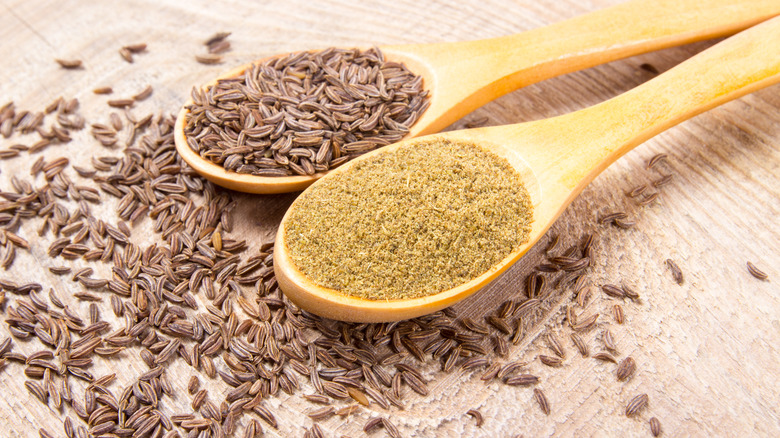Ayurvedic
Shwet Jeeraka (Cuminum cyminum) Herb Ayurvedic Overview
Shwet Jeeraka (Cuminum cyminum) is popular as a culinary spice and used in folklore therapy because of the presence of aromatic substances in the herb. Cumin comes under the category of traditional spice from the middle ages. It is an annual cultivated herb, with an erect, round, slender, branched stem, about a foot high. Cultivation of Cumin needs hot climate to grow and it is of around 30 c temperature. It is native to India, Egypt, Mexico, China, and North Africa.
Cumin has been used as anti-inflammatory, diuretic, carminative, and antispasmodic, also works in managing the symptoms of dyspepsia, jaundice, diarrhea, flatulence, and indigestion. Other pharmacological properties of Cuminum cyminum include hypotensive, antifertility, antidiabetic, anti-histaminic, anti-oxidant, anti-microbial, anti-tumor, and boost immune system.
Table of Contents
Scientific Classification of Shwet Jeeraka (Cuminum cyminum):
- Kingdom: Plantae
- Sub-Kingdom: Viridiplantae
- Infra Kingdom: Streptophyta (Land plants)
- Super Division: Embryophyta
- Division: Tracheophyta
- Sub Division: Spermatophytina
- Class: Magnoliopsida
- Super Order: Asteranae
- Order: Apiales
- Family: Apiaceae
- Genus: Cuminum-cumin
- Species: Cuminum cyminum
Shwet Jeeraka (Cuminum cyminum) Synonyms:
- Sanskrit: Ajaji, Jiraka, Ajajika
- Assamese: Jira
- Bengali: Jira, Sadajira
- English: Cumin seed, Cumin
- Gujrati: Jirautmi, Jirn, Jiraugi, Jeeru, Jirun
- Hindi: Jira, Safed jira
- Kannada: Jirage, Bilejirege
- Kashmiri: Safed Zoor
- Malayalam: Jeerakam
- Marathi: Pandhare jire
- Oriya: Dhalajeera, Dalajira, Jira
- Punjabi: Safed Jira, Chitta Jira
- Tamil: Sheeragam, Chirakam, Jeerakam
- Telugu: Jilakarra, Tella Jilakarra
- Urdu: Zirah, Zirasafed
Shwet Jeeraka (Cuminum cyminum) Description:
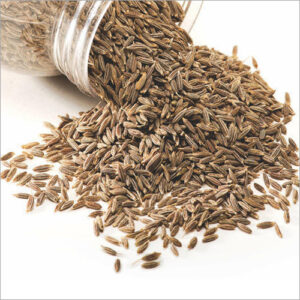 Macroscopic: The fruit of jeeraka is cremocarp, often separated into mericarps having brown with light-colored ridges, elongated about 4-6 mm long, 2 mm wide, tapering at ends, and slightly compressed laterally. The mericarps having 5 longitudinal hairy primary ridges from base to apex alternating with 4 secondary ridges which are flatter and bear conspicuous emergences. The seeds are orthospermous, the odor is umbelliferous characteristics, and the taste is richly spicy.
Macroscopic: The fruit of jeeraka is cremocarp, often separated into mericarps having brown with light-colored ridges, elongated about 4-6 mm long, 2 mm wide, tapering at ends, and slightly compressed laterally. The mericarps having 5 longitudinal hairy primary ridges from base to apex alternating with 4 secondary ridges which are flatter and bear conspicuous emergences. The seeds are orthospermous, the odor is umbelliferous characteristics, and the taste is richly spicy.
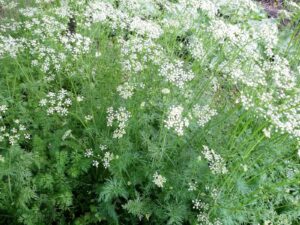 Leaves: The leaves are multi-fid having long filiform segments. The leaves are 5-10 cm long, pinnate or bipinnate having thread like leaflets. The margins of leaves are dentate and lobbed. Leaf color is deep green, sometimes turning black at the ends and its upper leaves have very short stalks and lower leaves have longer stalks.
Leaves: The leaves are multi-fid having long filiform segments. The leaves are 5-10 cm long, pinnate or bipinnate having thread like leaflets. The margins of leaves are dentate and lobbed. Leaf color is deep green, sometimes turning black at the ends and its upper leaves have very short stalks and lower leaves have longer stalks.
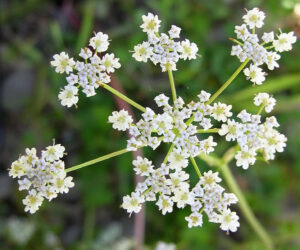 Flowers: The flowers of jeeraka are small, white, or pink are overtopped by the bracts, which, after flowering. The Inflorescence of flower is Umbel. The petals are 4-5. Each umbel has 5 to 7 umbellets or clusters that make a canopy, giving it a fluffy appearance.
Flowers: The flowers of jeeraka are small, white, or pink are overtopped by the bracts, which, after flowering. The Inflorescence of flower is Umbel. The petals are 4-5. Each umbel has 5 to 7 umbellets or clusters that make a canopy, giving it a fluffy appearance.
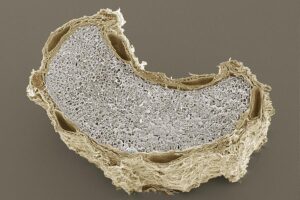 Microscopic: The transverse section of fruit shows epidermis consisting of short polygonal, tabular cells densely covered with short, bristle hairs on ridges, mesocarp with few layers of parenchyma, and five vascular bundles under five primary ridges. There are six vittae under secondary ridges, four on the dorsal surface and two on the commissural surface. The endocarp consists of polygonal cells containing fixed oil and aleurone grains carpophore consists of slender fibers.
Microscopic: The transverse section of fruit shows epidermis consisting of short polygonal, tabular cells densely covered with short, bristle hairs on ridges, mesocarp with few layers of parenchyma, and five vascular bundles under five primary ridges. There are six vittae under secondary ridges, four on the dorsal surface and two on the commissural surface. The endocarp consists of polygonal cells containing fixed oil and aleurone grains carpophore consists of slender fibers.
Identity, Purity, and Strength of Shwet Jeeraka (Cuminum cyminum):
- Foreign matter Not more than 2 percent, Appendix 2.2.2.
- Total Ash Not more than 8 percent, Appendix 2.2.3.
- Acid-insoluble ash Not more than 1 percent, Appendix 2.2.4.
- Alcohol-soluble extractive Not less than 7 percent, Appendix 2.2.6.
- Water-soluble extractive Not less than 15 percent, Appendix 2.2.7.
Chemical Constituents of Shwet Jeeraka (Cuminum cyminum):
The seeds of cumin are rich in aldehyde (60%) fats, amino acids, flavonoids and glycosides (22%), volatile oil (2-5%) and the yellow-colored fresh oil contains cuminaldehyde as its chief component. Other than this, the identified essential oils in cumin are benzoic acid, thymol, anisyl alcohol, limonene, cuminaldehyde, anethole, and vanillin. The presenting organic acids in cumin are tartaric, propionic, ascorbic, oxalic, aspartic, citric, malic, maleic, and fumaric acids and phenols are salicylic acid, gallic acid, cinnamic acid.
Ayurvedic Properties and Action of Shwet Jeeraka (Cuminum cyminum):
- Rasa (taste): Katu (pungent)
- Guna (quality): Laghu (light), Ruksha (dry)
- Virya (potency): Ushna (hot)
- Vipaka (resultant): Katu (pungent)
- Prabhava (action): Digestive
- Dosha Karma (effect on humors): Kapha and Vata Dosha hara
Ayurvedic Formulation made by Shwet Jeeraka (Cuminum cyminum):
Hingvadi churna, Jirakadyarishta, Hingwadi churna, Jirakadimodaka, Lavan Bhaskar churna, Yograj Guggul, Mahayograj Guggul.
Therapeutic Uses of Shwet Jeeraka (Cuminum cyminum):
Jwaraghan, Pachaya, Balaya, Chakshushaya, Ruchya, Medhya, Deepana, Grahi, Agnivardhak, Krumi, Chardi, Kushta, Atisara, Adhmana, Grahani.
Dose of Shwet Jeeraka (Cuminum cyminum):
1-3 gm of the drug in powder form.
Reference:
Ayurvedic Pharmacopeia of India.
For regular health updates, Please follow our Social Pages

